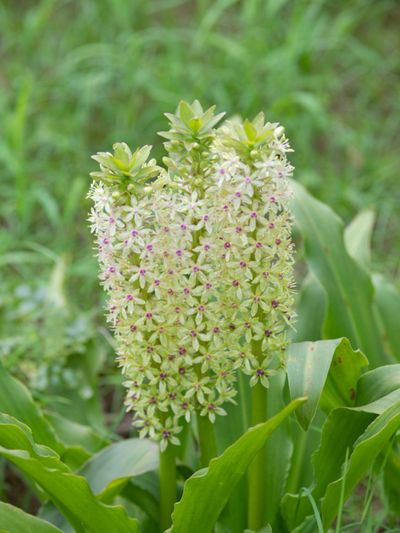About the Pineapple Lilies
Pineapple lilies are in the genus Eucomis and include a wide range of tropical plants native to warm moist regions of the world. A little known fact about pineapple lilies is that they are actually related to asparagus. Both plants are in the Lily family. Pineapple lily plants grow from bulbs. These interesting bulbs start out as a rosette and do not usually start blooming for a year. Then annually, the plants produce the pineapple shaped flowers in July to August. Some varieties carry a faint, unpleasant scent. The flower is actually comprised of many tiny little flowers clustered together in a cone shape. The colors vary but are usually white, cream or flecked with violet. The pineapple lily has pointed, spear-like leaves and a flowering stem that rises above the plant. Most varieties are easily injured in temperatures below 68 degrees F. (20 C.), but some are hardy in temperate zones like the Pacific Northwest. The plant is hardy in USDA zones 10 and 11 but can be grown down to zone 8 if it is dug up and overwintered indoors. These plants are clumping over time and may get 2 to 3 feet (61-91 cm.) wide over time.
How to Grow a Pineapple Lily Flower
Growing pineapple lilies is easy. In zones of 9 or below, start them in pots and then transplant them outdoors after the danger of frost has passed. Plant the bulbs in well prepared soil with excellent drainage. Work in a few inches (8 cm.) of compost or leaf litter to increase the tilth and nutrient content of the planting bed. Dig holes 6 to 12 inches (15-31 cm.) deep, every 6 inches (15 cm.). Place the bulbs in full sun in spring once soils have warmed to 60 degrees F. (16 C.). Growing pineapple lilies in a deep container will help you save the bulbs. Move the containers indoors when temperatures drop in fall.
Caring for Pineapple Lily Plants
No fertilizer is required when caring for pineapple lily plants, but they do appreciate a mulch of manure spread around the base of the plant. If you are going to move the bulbs indoors for winter, allow the foliage to persist as long as possible so the plant can gather energy from the sun to fuel the next season’s bloom. After you dig up the bulbs, lay them out in a cool, dry location for a week, then wrap them in newspaper and place them in a paper bag or cardboard box.
